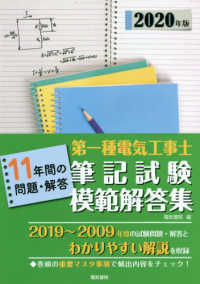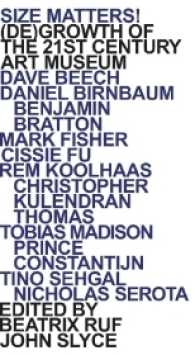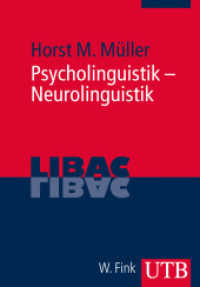- ホーム
- > 洋書
- > 英文書
- > Science / Mathematics
Full Description
The volume introduces contaminated land management cases, including planning, assessment, decision making, remediation and verification of the technology at sites representing contamination by organic and inorganic contaminants, and from point and diffuse sources. These case studies demonstrate the applicability and suitability of versatile engineering tools and their integrated application in order to manage the environment in a holistic way.Two of the four case study sites are contaminated by organic, two others by inorganic pollutants. The sites contaminated by organic pollutants are relatively small and delineated ones, the others are diffusely contaminated catchments. An oil spill occurred at a transformer station of a former industrial facility in the middle of the People's Park, a Budapest, Hungary recreation area. Transformer oil contamination was identified (as non-polychlorinated biphenyls) and found both in the saturated and unsaturated soil zones. It was moderately biodegradable due to low mobility and bioavailability. The site underwent a complex assessment, which was followed by microcosm testing, and, finally, a combined technology - cyclodextrin enhanced flushing, bioventing and ex situ water treatment - was designed and implemented. The technology was verified using technology monitoring and site monitoring data.The site of a former metal processing plant was contaminated by a mixture of chlorinated solvents, mainly in the saturated soil zone and the groundwater, down to the surface of the impermeable layer. A combination of processes and technologies was applied: mobilization by solubilization, treatment with additives via wells, directed groundwater flow to reach the entire area, in situ enhanced biodegradation and ex situ physico-chemical water treatment. A number of laboratory microcosms preceded the design of the field experiments. The monitoring used the integrated physico-chemical, biological and toxicological methods. Evaluation and verification of the technology were also introduced. The contaminations by inorganic pollutants, both of mining origin, appeared at a catchment scale.The area of a former zinc and lead mine overlaps with a natural recreational area and a village downstream with gardens and agricultural land. Pollution from several point sources caused a typical diffuse pollution. Mapping and planning risk reduction was supported by a GIS-based risk assessment. Several microcosms and field plots were tested to determine the parameters and ranges of the GIS-based transport model and the best remedial technology option. Validation was done after the complex remediation and rehabilitation of the former mining site. Risk reduction and rehabilitation included waste disposal and isolation as well as the remediation of the soils in the remaining contaminated subareas and smaller sites by the combination of chemical and phytostabilization.
Contents
ContentsCASE STUDIES:1. Organic pollutants: complete case studiesa. Nepliget b. Mezolak2. Inorganic pollutants: complete case studiesa. Gyoengyoesoroszi case study: management of sulfidic mine waste and acid rockb. Red mud spill in Hungary: risk assessment and risk reduction








